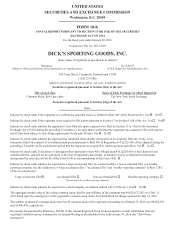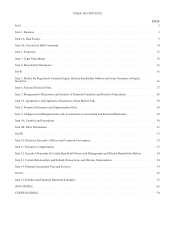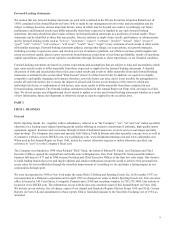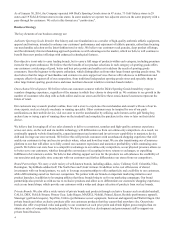Dick's Sporting Goods 2015 Annual Report Download - page 15
Download and view the complete annual report
Please find page 15 of the 2015 Dick's Sporting Goods annual report below. You can navigate through the pages in the report by either clicking on the pages listed below, or by using the keyword search tool below to find specific information within the annual report.
ITEM 1A. RISK FACTORS
Risks and Uncertainties
Our business is dependent on consumer discretionary spending and reduced consumer spending may adversely affect the
Company's business, operations, liquidity, financial results and stock price.
Our business depends on consumer discretionary spending, and as a result, our results are highly dependent on U.S. consumer
confidence and the health of the U.S. economy. Consumer spending may be affected by many factors outside of the Company’s
control, including general economic conditions, consumer disposable income levels, consumer confidence levels, the
availability, cost and level of consumer debt, the costs of basic necessities and other goods and the effects of the weather or
natural disasters. Decreases in consumer discretionary spending can result in the need for more promotional activities and a
decrease in same store sales, customer traffic or average value per transaction, which could negatively affect the Company's
business, financial performance and/or stock price, particularly if consumer spending is depressed for a prolonged period of
time.
Intense competition in the sporting goods industry and in retail could limit our growth and reduce our profitability.
The market for sporting goods retailers is highly fragmented and intensely competitive. Our current and prospective
competitors include many large companies, some of which have greater market presence, name recognition and financial,
marketing and other resources than we do. Additionally, the ability of consumers to compare prices on a real-time basis through
the use of smartphones and digital technology puts additional pressure on us to maintain competitive prices vis-à-vis our
competitors. We compete with retailers from multiple categories, including large formats, traditional and specialty formats,
mass merchants, department stores and catalog, internet-based and direct-sell retailers. Many factors affect the extent to which
competition could affect our results, including pricing, quality, assortment, advertising, service, locations and reputation, and
prolonged competitive pressures could have a material effect on our results of operations.
Omni-channel growth in our business is complex and we are currently developing an internal eCommerce platform.
Our business has become increasingly omni-channel so our customers are able to shop online or in-store for a seamless
shopping experience. Our omni-channel strategy includes the planned transition to an internal eCommerce platform, and the
www.DICKS.com eCommerce business is planned to be launched on the internal eCommerce platform in early 2017. Installing
our new, internal eCommerce platform involves substantial investment of capital and resources, integrating a number of
information and management systems from different vendors, increasing supply chain and distribution capabilities, attracting,
developing and retaining qualified personnel with relevant subject matter expertise, and effectively managing the customer
experience. This involves substantial risk, including risk of implementation delays, cost overruns, technology interruptions,
supply and distribution delays, and other issues that can affect the successful implementation and operation of our internal
eCommerce platform. If we are not able to successfully implement and operate our internal eCommerce platform, our financial
performance and future growth could be materially adversely affected.
If we are unable to predict or effectively react to changes in consumer demand or shopping patterns, we may lose customers
and our sales may decline.
Our success depends in part on our ability to anticipate and respond in a timely manner to changing consumer demand,
preferences and shopping patterns regarding sporting goods. We must develop and execute merchandising initiatives with
marketing programs that appeal to a broad range of consumers and markets throughout the country. Consumer preferences
cannot be predicted with certainty and are subject to continual change and evolution. Additionally, our customers may also have
expectations about how they shop in stores or through eCommerce or more generally engage with businesses across different
channels or media (through internet-based and other digital or mobile channels or particular forms of social media), which may
vary across demographics and may evolve rapidly. We often make commitments to purchase products from our vendors several
months in advance of the proposed delivery. If we misjudge the market for our new merchandise our sales may decline
significantly, we may have to take significant inventory markdowns or miss opportunities for other products, which could have
a negative impact on our profitability.
9
























